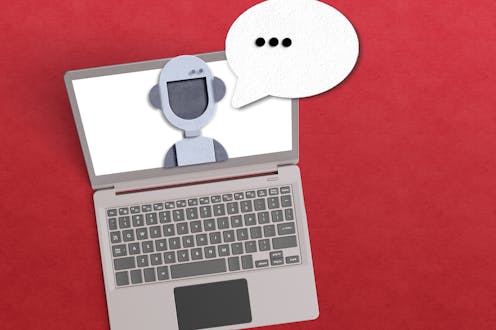Asking ChatGPT vs Googling: Can AI chatbots boost human creativity?
- Written by Jaeyeon Chung, Assistant Professor of Business, Rice University

Think back to a time when you needed a quick answer, maybe for a recipe or a DIY project. A few years ago, most people’s first instinct was to “Google it.” Today, however, many people are more likely to reach for ChatGPT[1], OpenAI’s conversational AI, which is changing the way people look for information.
Rather than simply providing lists of websites, ChatGPT gives more direct, conversational responses. But can ChatGPT do more than just answer straightforward questions? Can it actually help people be more creative?
I study new technologies and consumer interaction[2] with social media. My colleague Byung Lee[3] and I set out to explore this question: Can ChatGPT genuinely assist people in creatively solving problems, and does it perform better at this than traditional search engines like Google?
Across a series of experiments in a study published in the journal Nature Human Behavour, we found that ChatGPT does boost creativity[4], especially in everyday, practical tasks. Here’s what we learned about how this technology is changing the way people solve problems, brainstorm ideas and think creatively.
ChatGPT and creative tasks
Imagine you’re searching for a creative gift idea for a teenage niece. Previously, you might have googled “creative gifts for teens” and then browsed articles until something clicked. Now, if you ask ChatGPT, it generates a direct response based on its analysis of patterns across the web. It might suggest a custom DIY project or a unique experience, crafting the idea in real time.
To explore whether ChatGPT surpasses Google in creative thinking tasks, we conducted five experiments where participants tackled various creative tasks. For example, we randomly assigned participants to either use ChatGPT for assistance, use Google search, or generate ideas on their own. Once the ideas were collected, external judges, unaware of the participants’ assigned conditions, rated each idea for creativity. We averaged the judges’ scores to provide an overall creativity rating.
One task involved brainstorming ways to repurpose everyday items, such as turning an old tennis racket and a garden hose into something new. Another asked participants to design an innovative dining table. The goal was to test whether ChatGPT could help people come up with more creative solutions compared with using a web search engine or just their own imagination.
The results were clear: Judges rated ideas generated with ChatGPT’s assistance as more creative[6] than those generated with Google searches or without any assistance. Interestingly, ideas generated with ChatGPT – even without any human modification – scored higher in creativity than those generated with Google.
One notable finding was ChatGPT’s ability to generate incrementally creative ideas: those that improve or build on what already exists. While truly radical ideas might still be challenging for AI, ChatGPT excelled at suggesting practical yet innovative approaches. In the toy-design experiment, for example, participants using ChatGPT came up with imaginative designs, such as turning a leftover fan and a paper bag into a wind-powered craft.
Limits of AI creativity
ChatGPT’s strength lies in its ability to combine unrelated concepts[7] into a cohesive response. Unlike Google, which requires users to sift through links and piece together information, ChatGPT offers an integrated answer that helps users articulate and refine ideas in a polished format. This makes ChatGPT promising as a creativity tool, especially for tasks that connect disparate ideas or generate new concepts.
It’s important to note, however, that ChatGPT doesn’t generate truly novel ideas. It recognizes and combines linguistic patterns from its training data, subsequently generating outputs with the most probable sequences[8] based on its training. If you’re looking for a way to make an existing idea better or adapt it in a new way, ChatGPT can be a helpful resource. For something groundbreaking, though, human ingenuity and imagination are still essential[9].
Additionally, while ChatGPT can generate creative suggestions, these aren’t always practical or scalable without expert input. Steps such as screening, feasibility checks, fact-checking and market validation require human expertise. Given that ChatGPT’s responses may reflect biases in its training data, people should exercise caution in sensitive contexts such as those involving race or gender.
We also tested whether ChatGPT could assist with tasks often seen as requiring empathy, such as repurposing items cherished by a loved one. Surprisingly, ChatGPT enhanced creativity even in these scenarios[10], generating ideas that users found relevant and thoughtful. This result challenges the belief that AI cannot assist with emotionally driven tasks.
Future of AI and creativity
As ChatGPT and similar AI tools become more accessible, they open up new possibilities for creative tasks. Whether in the workplace or at home, AI could assist in brainstorming, problem-solving and enhancing creative projects. However, our research also points to the need for caution: While ChatGPT can augment human creativity, it doesn’t replace the unique human capacity for truly radical, out-of-the-box thinking.
This shift from Googling to asking ChatGPT represents more than just a new way to access information. It marks a transformation in how people collaborate with technology to think, create and innovate.
References
- ^ reach for ChatGPT (www.washingtonpost.com)
- ^ study new technologies and consumer interaction (scholar.google.com)
- ^ Byung Lee (www.bauer.uh.edu)
- ^ ChatGPT does boost creativity (doi.org)
- ^ Simon Ritzmann/DigitalVision via Getty Images (www.gettyimages.com)
- ^ more creative (doi.org)
- ^ combine unrelated concepts (doi.org)
- ^ generating outputs with the most probable sequences (papers.nips.cc)
- ^ human ingenuity and imagination are still essential (hbswk.hbs.edu)
- ^ even in these scenarios (doi.org)
Authors: Jaeyeon Chung, Assistant Professor of Business, Rice University
Read more https://theconversation.com/asking-chatgpt-vs-googling-can-ai-chatbots-boost-human-creativity-242584


